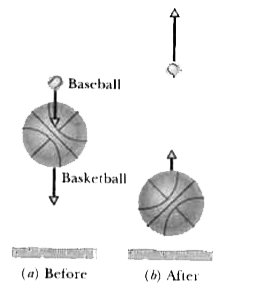A small ball of mass m is aligned above a larger ball of mass M = 0.63 kg (with a slight separation, as with the baseball and basket ball of Fig. ), and the two are dropped simultaneously from a height of h = 1.8 m. (Assume the radius of each ball is negligible relative to h.) (a) If the larger ball rebounds elastically from small ball rebounds elastically from the larger ball, what value of m results in the larger ball stopping when it collides with the small ball ? (b)What height does the small ball then reach ?

The correct Answer is:(a)0.21 kg ; (b) 7.2 m
Step by step video & image solution for A small ball of mass m is aligned above a larger ball of mass M = 0.63 kg (with a slight separation, as with the baseball and basket ball of Fig. ), and the two are dropped simultaneously from a height of h = 1.8 m. (Assume the radius of each ball is negligible relative to h.) (a) If the larger ball rebounds elastically from small ball rebounds elastically from the larger ball, what value of m results in the larger ball stopping when it collides with the small ball ? (b)What height does the small ball then reach ? by Physics experts to help you in doubts & scoring excellent marks in Class 12 exams.
Updated on:21/07/2023Topper's Solved these Questions
- CENTER OF MASS BOOK - RESNICK AND HALLIDAYCHAPTER - CENTER OF MASS EXERCISE - Practice Questions (Single Correct Choice )
47 Videos
- CENTER OF MASS BOOK - RESNICK AND HALLIDAYCHAPTER - CENTER OF MASS EXERCISE - Practice Questions (More than One Correct Choice)
5 Videos
- CENTER OF MASS BOOK - RESNICK AND HALLIDAYCHAPTER - CENTER OF MASS EXERCISE - Practice Questions (Integer )
4 Videos
- CAPACITANCEBOOK - RESNICK AND HALLIDAYCHAPTER - CAPACITANCEEXERCISE - PRACTICE QUESTION (INTEGER TYPE)
3 Videos
- CIRCUITSBOOK - RESNICK AND HALLIDAYCHAPTER - CIRCUITSEXERCISE - Practice Questions (Integer Type)
3 Videos
Similar Questions
Knowledge Check
A ball is dropped from a height of 10 m, as it falls,
Aits velocity increases and acceleration decreases.Bits velocity decreases and acceleration increases.Cits velocity increases and acceleration remains constant.Dits velocity and acceleration remains constant.A ball of mass m1, collides elastically and head on with ball of mass m2 at rest. Then
AThe transfer of kinetic energy to the second ball is maximum when m1=m2BThe change of momentum of first ball is maximum, when m1<<m2.CThe velocity of the second ball is maximum, when m1>>m2.DNone of theseA ball of mass m strikes a rigid walJ with speed u and rebounds with the same speed. The impulse imparted to the ball by the wall is
A2muBmuCzeroD−2mu
A ball of mass m strikes a rigid walJ with speed u and rebounds with the same speed. The impulse imparted to the ball by the wall is

View SolutionA ball of mass m strikes the fixed inclined plane after falling through a height h. if it rebounds elastically. The impulse on the ball is :

View SolutionA ball is dropped from a height of 5 m, if it rebound upto height of 1.8 m, then the ratio of velocities of the ball after and before rebound is :
View SolutionA ball of mass 'm' strikes a rigid wall with speed 'u' and rebounds with the same speed. The impulse imparted to the ball by the wall is
View SolutionA rubber ball is dropped on the ground from a height of 1m. What is the height to which the ball will rebound, if the coefficient of restitution between the ball and the ground is 0.8?
View Solution
